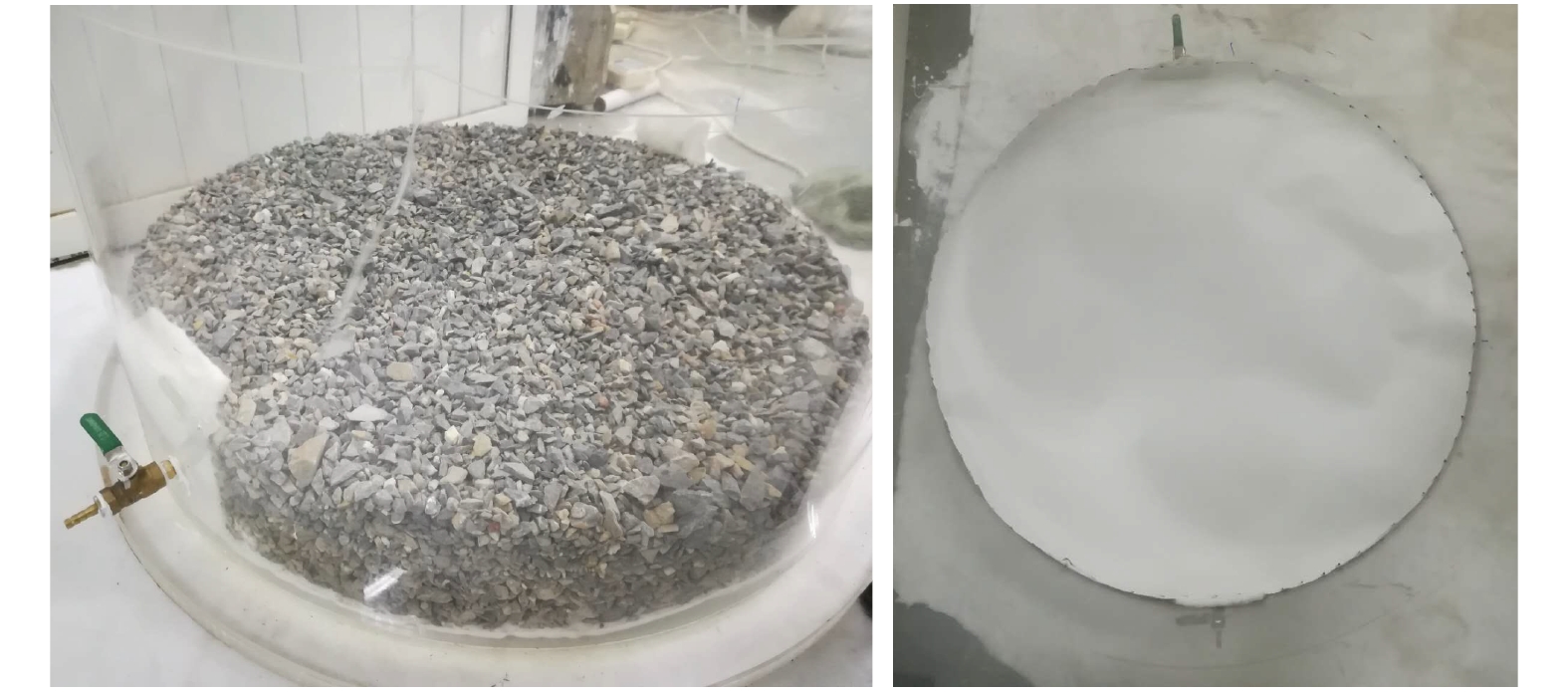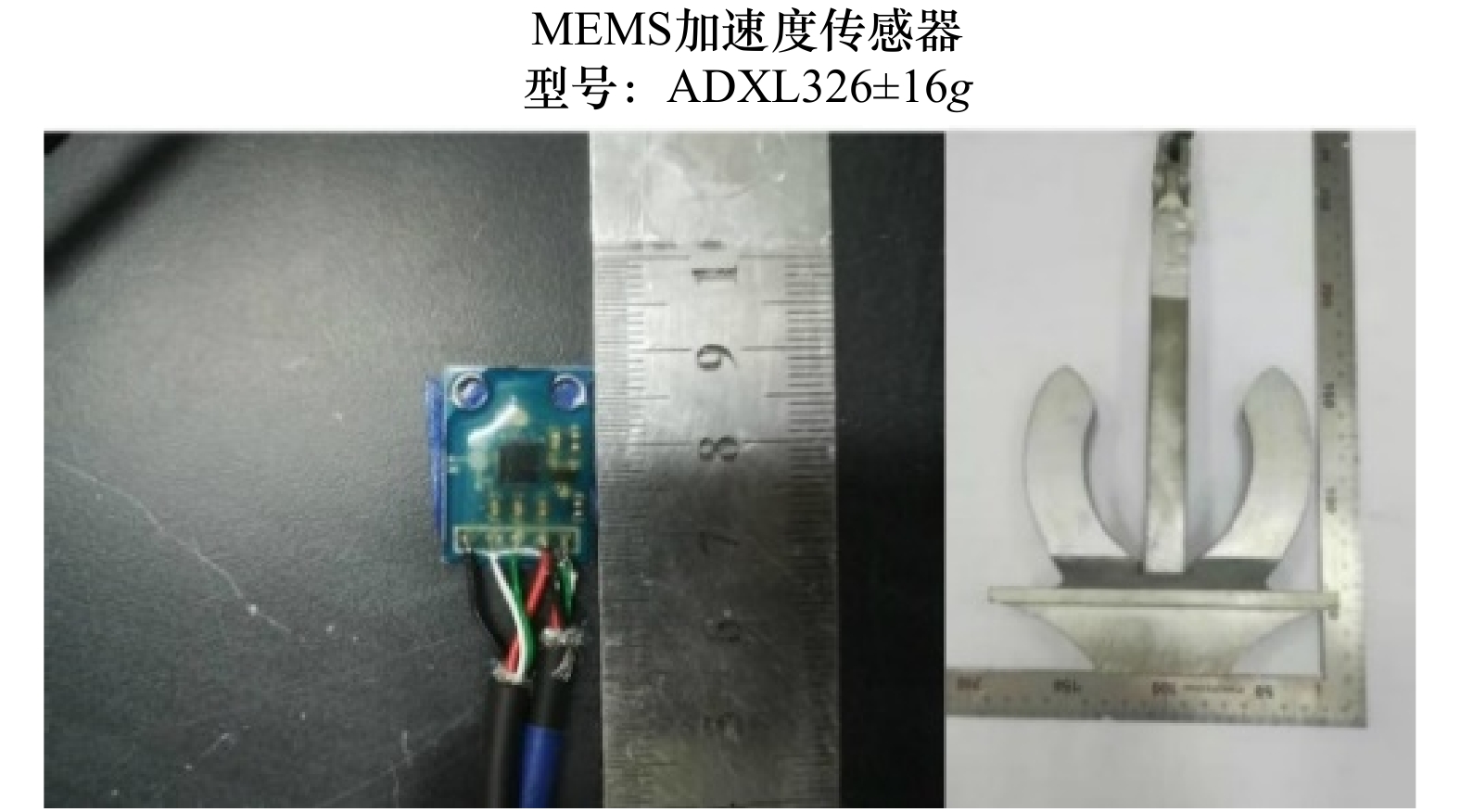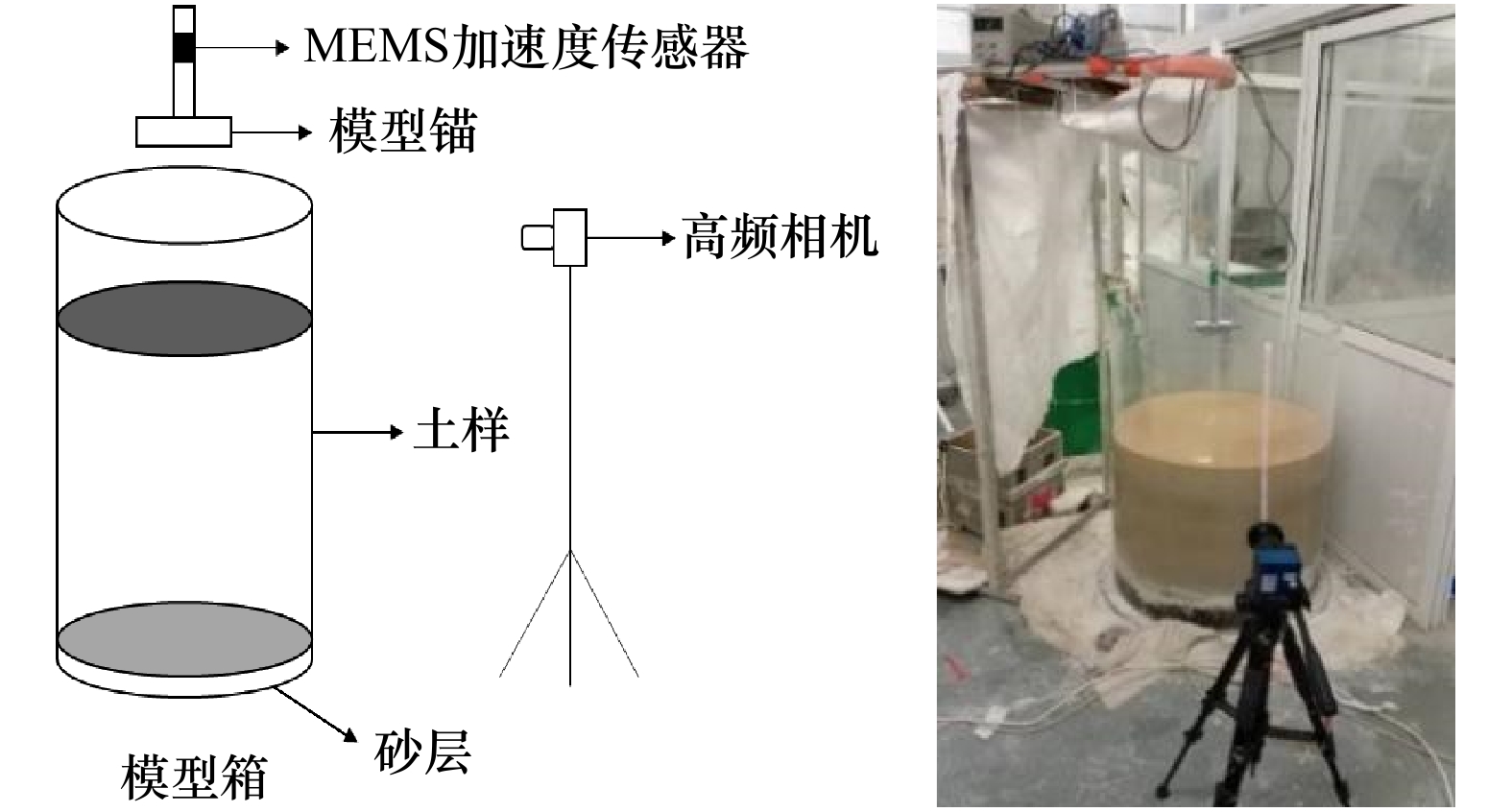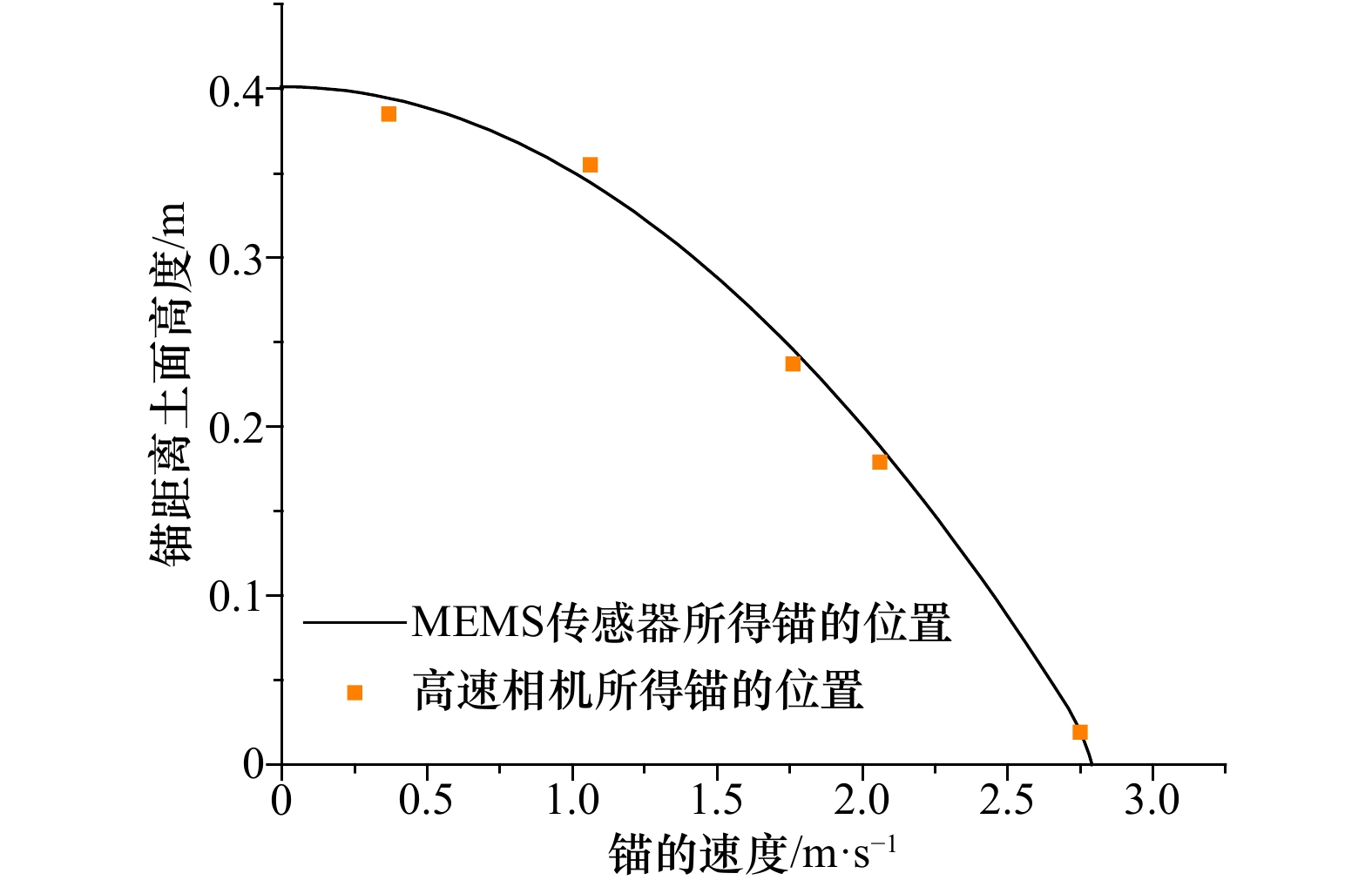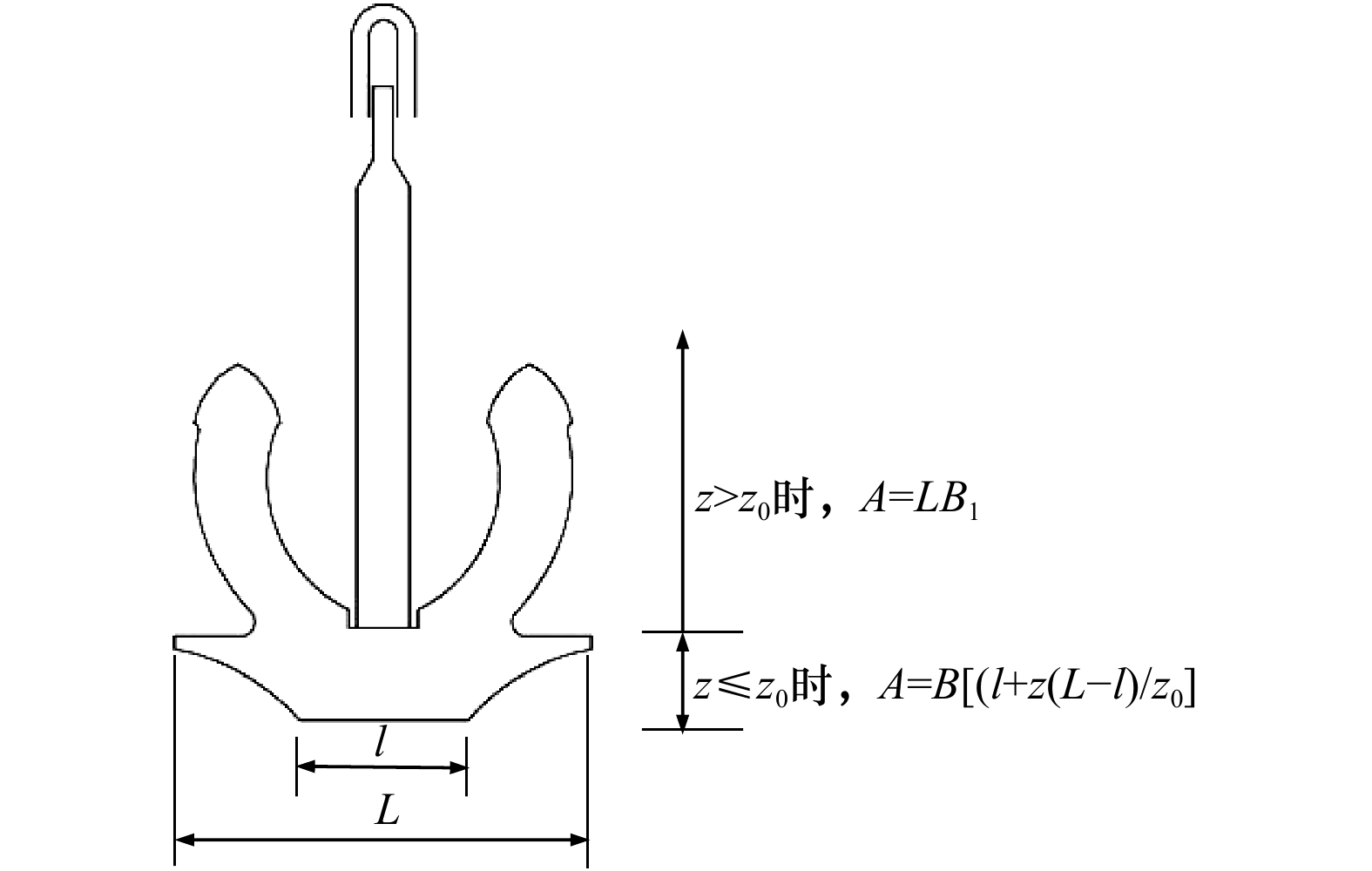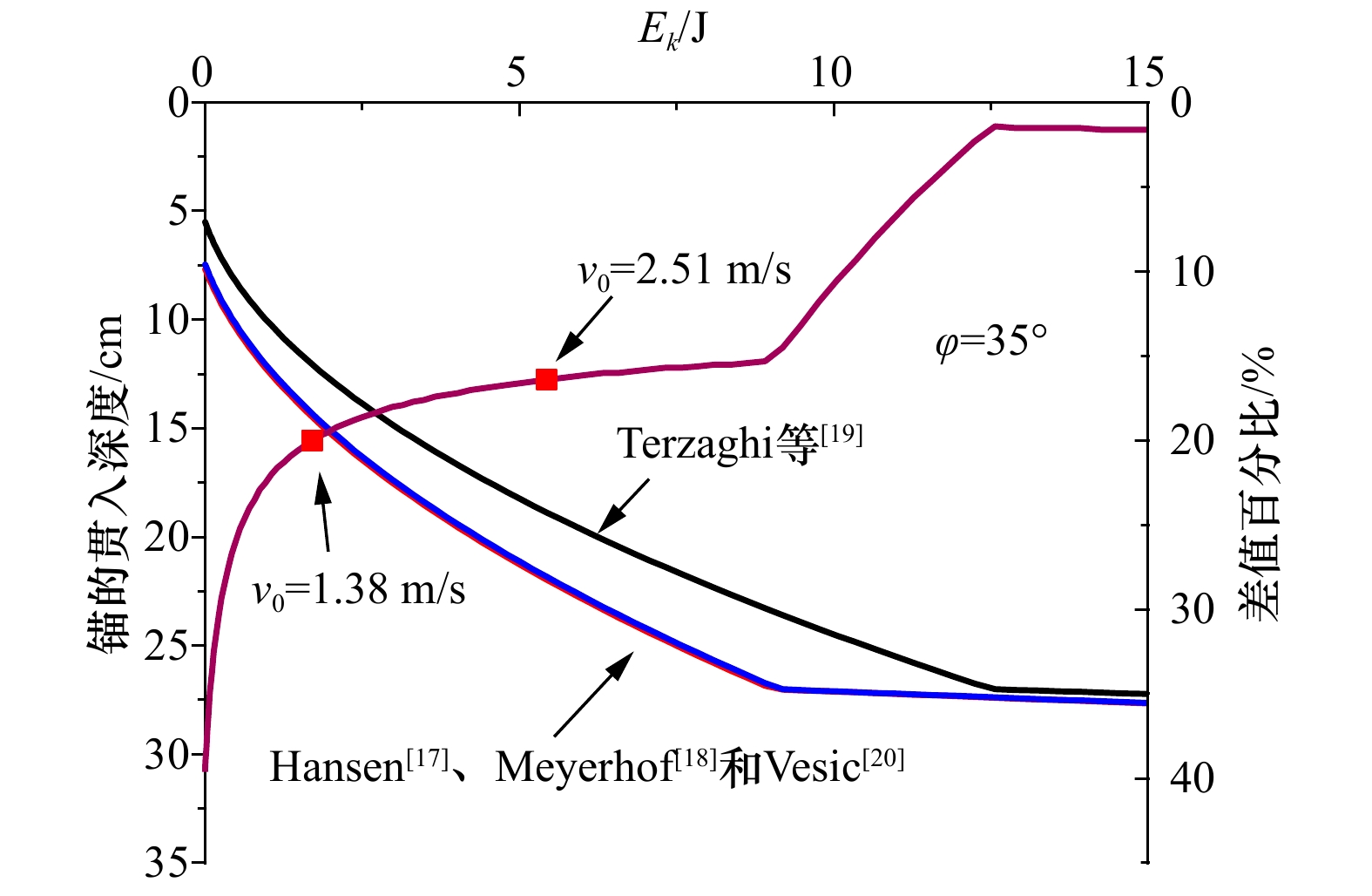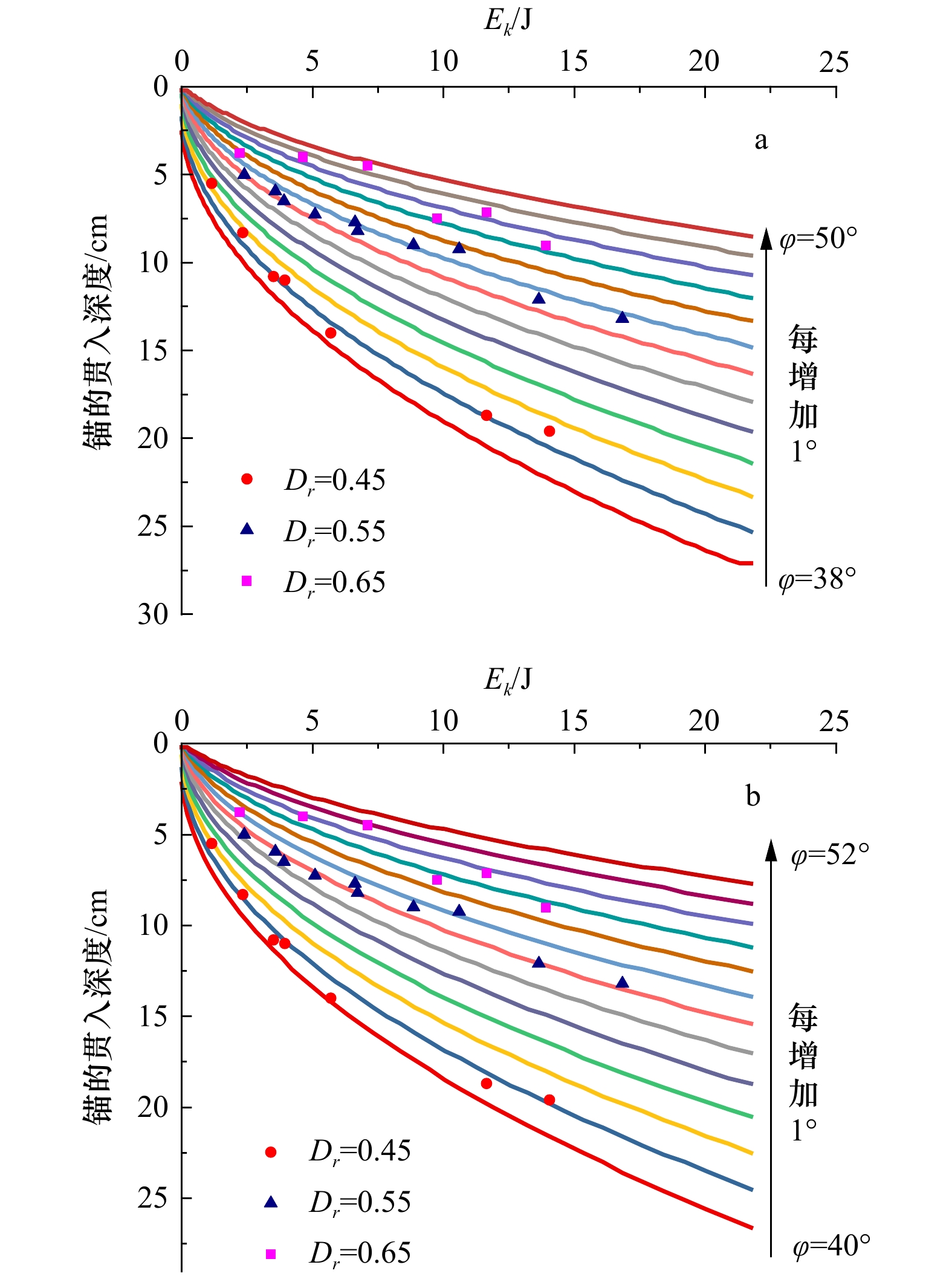Model tests on penetration depth of hall anchor in silty sand
-
摘要: 航船应急抛锚时锚板贯入土体可能会影响河床或海床中的结构物甚者造成破坏,因此在通航频繁的航道,结构物埋深的设计需要充分考虑应急抛锚时锚板的贯入深度。本文通过缩尺模型试验模拟了霍尔锚在中等密实度粉细砂中的抛锚贯入过程,研究了不同抛锚速度(1.15~4.4 m/s)及粉细砂相对密实度(0.45~0.65)对抛锚贯入深度的影响;基于太沙基极限承载力理论和能量守恒定律,推导出霍尔锚在粉细砂土中贯入深度的表达式,与模型试验结果对比显示理论计算结果偏于保守。基于试验结果提出修正系数,修正后的理论公式能够较好地快速预测霍尔锚在中等密实度粉细砂中的贯入深度。研究结果为粉细砂土河床或海床中的结构物埋深设计提供了一定的技术参考。Abstract: The structures in the riverbed or seabed may be affected or damaged by emergency anchoring. In the channel with frequent navigation, the emergency anchoring penetration depth need to be fully considered during the design of the buried depth of structures in riverbed. In this paper, small scale model tests are carried out to simulate the process of anchoring penetration of hall anchor in silty sand, and the influences of different impact velocities (1.15−4.4 m/s) and relative density of silty sand (0.45−0.65) on anchoring penetration depth are investigated. Based on the Terzaghi ultimate bearing capacity theory and the energy conservation law, the expression of penetration depth of the hall anchor in silty sand is deduced, and the theoretical calculation results are conservative compared with experimental results, the revised results of the theoretical calculation results are in good agreement with experimental data. The research results can provide a reference for the design of buried depth of structures in silty sand riverbed or seabed.
-
Key words:
- Hall anchor /
- silty sand /
- penetration depth /
- impact velocity
-
表 1 砂土中船锚动力贯入模型试验相似关系
Tab. 1 Similarity relationships of dynamic penetration model tests in sand
物理量 长度L 面积A 速度v 抛锚深度z 重力W 阻力Fs 内摩擦角φ 动能Ek 势能Ep 比尺 λL λA λv λz λW λF λφ λE λp 相似关系 λL $ {\lambda_L^2}$ $ {\lambda_L^{1/2}}$ λL $ {\lambda_L^3}$ $ {\lambda_L^3}$ 1 $ {\lambda_L^4}$ $ {\lambda_L^4}$ 模型试验 1/λL 1/$ {\lambda_L^2}$ 1/$ {\lambda_L^{1/2}}$ 1/λL 1/$ {\lambda_L^3}$ 1/$ {\lambda_L^3}$ 1 1/$ {\lambda_L^4}$ 1/$ {\lambda_L^4}$ 表 2 霍尔锚模型尺寸
Tab. 2 Hall anchor model size
锚重/kg H/mm h/mm h1/mm L/mm L1/mm B/mm B1/mm 模型 1.74 193.27 104.6 23 148.93 104.6 57.93 68.73 原型 5610 2899 1569 345 2234 1569 869 1031 注:表中各符号代表的含义标注在图2中。 表 3 模型试验土样颗粒筛分结果
Tab. 3 Partical screening test result of soil sample
颗粒直径/mm 0.25~0.5 0.075~0.25 <0.075 试验土颗粒组成百分数 17.5% 50% 32.5% 现场土颗粒组成百分数 8.3% 58.4% 33.2% 表 4 不同相对密实度下土体干密度与内摩擦角
Tab. 4 Dry density and internal friction angle of soil sample under different relative density
相对密实度 0.45 0.55 0.65 干密度/g·cm−3 1.457 1.515 1.577 内摩擦角/(°) 36.9 38.9 39.5 表 5 抛锚试验工况及结果
Tab. 5 Tests conditions and results
工况 抛锚高度/m Dr 抛锚速度/m·s−1 贯入深度/m 模型 原型 模型 原型 H1 0.09 0.45 1.15 4.45 0.055 0.825 H2 0.15 0.45 1.64 6.35 0.083 1.245 H3 0.21 0.45 2.01 7.78 0.108 1.620 H4 0.25 0.45 2.13 8.25 0.110 1.650 H5 0.35 0.45 2.56 9.91 0.140 2.100 H6 0.70 0.45 3.66 14.18 0.187 3.405 H7 0.84 0.45 4.02 15.57 0.196 3.890 H8 0.15 0.55 1.66 6.42 0.050 0.750 H9 0.22 0.55 2.03 7.86 0.059 0.891 H10 0.25 0.55 2.12 8.22 0.065 0.975 H11 0.30 0.55 2.42 9.39 0.073 1.089 H12 0.40 0.55 2.76 10.71 0.077 1.155 H13 0.41 0.55 2.78 10.78 0.082 1.230 H14 0.52 0.55 3.19 12.36 0.090 1.350 H15 0.62 0.55 3.49 13.50 0.092 1.386 H16 0.80 0.55 3.96 15.34 0.121 1.815 H17 1.00 0.55 4.40 17.06 0.132 1.980 H18 0.15 0.65 1.60 6.20 0.038 0.567 H19 0.28 0.65 2.31 8.95 0.040 0.600 H20 0.42 0.65 2.86 11.08 0.045 0.675 H21 0.59 0.65 3.35 12.97 0.075 1.125 H22 0.70 0.65 3.66 14.18 0.071 1.071 H23 0.82 0.65 4.00 15.49 0.090 1.354 表 6 各学者建议的承载力系数计算公式
Tab. 6 Formulas for calculating the bearing capacity coefficient recommended by various scholars
参考文献 Nc Nq Nγ 文献[19] ${\left( { {N_{{q} } } - 1} \right)\cot \varphi }$ ${\dfrac{ { {\rm{e}^{\left( {\dfrac{ {3{\text π} } }{2} - \varphi } \right)\tan \varphi } } } }{ {2{ {\cos }^2}\left( {\dfrac{ {\text π} }{4} + \dfrac{\varphi }{2} } \right)} } }$ ${1.8\left( { {N_{{q} } } - 1} \right)\tan \varphi }$ 文献[18] ${\left( { {N_{{q} } } - 1} \right)\cot \varphi }$ ${ {\rm{e}^{ {\text π} \tan \varphi } }{ {\tan }^2}\left( {\dfrac{ {\text π} }{4} + \dfrac{\varphi }{2} } \right)}$ ${\left( { {N_{{q} } } - 1} \right)\tan (1.4\varphi )}$ 文献[20] ${\left( { {N_{{q} } } - 1} \right)\cot \varphi }$ ${ {\rm{e}^{ {\text π} \tan \varphi } }{ {\tan }^2}\left( {\dfrac{ {\text π} }{4} + \dfrac{\varphi }{2} } \right)}$ ${2\left( { {N_{{q} } } - 1} \right)\tan \varphi }$ 文献[17] ${\left( { {N_{{q} } } - 1} \right)\cot \varphi }$ ${ {\rm{e}^{ {\text π} \tan \varphi } }{ {\tan }^2}\left( {\dfrac{ {\text π} }{4} + \dfrac{\varphi }{2} } \right)}$ ${1.8\left( { {N_{{q} } } - 1} \right)\tan \varphi }$ -
[1] 贾琇明, 岳来群, 韦子亮. 有关我国深海油气资源勘探开发的几点思考[J]. 国土资源情报, 2005(7): 5−7.Jia Xiuming, Yue Laiqun, Wei Ziliang. Some thoughts on exploration and development of oil and gas resources of China in deep sea[J]. Land and Resources Information, 2005(7): 5−7. [2] 王巍巍. 船舶应急抛锚贯入深度分析[J]. 船舶物资与市场, 2019(1): 37−38.Wang Weiwei. Analysis of emergency anchoring penetration depth[J]. Marine Equipment Materials & Marketing, 2019(1): 37−38. [3] Young C W. Penetration equations[R]. Albuquerque, New Mexico: Sandia National Laboratories, 1997: 4−12. [4] Raie M S, Tassoulas J L. Installation of torpedo anchors: numerical modeling[J]. Journal of Geotechnical and Geoenvironmental Engineering, 2009, 135(12): 1805−1813. doi: 10.1061/(ASCE)GT.1943-5606.0000159 [5] 韩聪聪, 陈学俭, 刘君. 霍尔锚抛锚深度模型试验研究[J]. 海洋工程, 2018, 36(5): 90−98.Han Congcong, Chen Xuejian, Liu Jun. Model tests on penetration depth of hall anchor[J]. The Ocean Engineering, 2018, 36(5): 90−98. [6] Han Congcong, Chen Xuejian, Liu Jun. Physical and numerical modeling of dynamic penetration of ship anchor in clay[J]. Journal of Waterway, Port, Coastal, and Ocean Engineering, 2019, 145(1): 04018030. doi: 10.1061/(ASCE)WW.1943-5460.0000490 [7] 洪大林, 谢瑞, 张思和, 等. 苏通长江公路大桥桥区河床抗冲性能试验研究[J]. 海洋工程, 2003, 21(4): 91−96. doi: 10.3969/j.issn.1005-9865.2003.04.015Hong Dalin, Xie Rui, Zhang Sihe, et al. Experiment test on river-bed erosion-resistant characteristics in the bridge region of Su-tong Yangtze River Highway Bridge[J]. The Ocean Engineering, 2003, 21(4): 91−96. doi: 10.3969/j.issn.1005-9865.2003.04.015 [8] 戚秀莲, 朱元生. 长江口南港河段水文泥沙特性及河床演变分析[J]. 海洋工程, 2000, 18(4): 74−79. doi: 10.3969/j.issn.1005-9865.2000.04.013Qi Xiulian, Zhu Yuansheng. Characteristics of hydrology and sediment and evolution of river bed in the southern branch of Yangtze Estuary[J]. Ocean Engineering, 2000, 18(4): 74−79. doi: 10.3969/j.issn.1005-9865.2000.04.013 [9] 李晓松, 孔宪卫. 船舶应急抛锚贯入深度研究[J]. 中国水运, 2017, 17(12): 15−16.Li Xiaosong, Kong Xianwei. Research on emergency anchoring penetration depth[J]. China Water Transport, 2017, 17(12): 15−16. [10] 杜颖, 陈峰, 徐伟. 砂土基质下落锚深度试验研究及计算方法[J]. 南方能源建设, 2018, 5(S1): 222−227.Du Ying, Chen Feng, Xu Wei. Experimental study and calculation method of falling anchor depth under sand soil[J]. Southern Energy Construction, 2018, 5(S1): 222−227. [11] 国家技术监督局. GB/T 546−1997, 霍尔锚[S]. 北京: 中国标准出版社, 1997.The State Bureau of Technology Supervision. GB/T 546−1997, Hall anchor[S]. Beijing: China Standard Press, 1997. [12] 国家质量技术监督局, 中华人民共和国建设部. GB/T 50123−1999, 土工试验方法标准[S]. 北京: 中国计划出版社, 1999.The State Bureau of Quality and Technical Supervision, Ministry of Construction, People’s Republic of China. GB/T 50123−1999, Standard for soil test method[S]. Beijing: China Planning Press, 1999. [13] DNV. DNV-RP-F107, Risk assessment of pipeline protection[S]. DNV, 2010. [14] 陈占刚. 从设计角度分析船舶进出港口通航安全控制[J]. 中国水运, 2008, 8(6): 14−15.Chen Zhan’gang. Analysis of navigation safety control of ships inward and outward the port from design perspective[J]. China Water Transport, 2008, 8(6): 14−15. [15] 于洋. 海洋运输船舶首锚重量统计分析[J]. 大连海事大学学报, 2016, 42(4): 33−40.Yu Yang. A statistic analysis of bow anchor weights of sea-going merchant ships[J]. Journal of Dalian Maritime University, 2016, 42(4): 33−40. [16] 中华人民共和国交通运输部. JTS 165−2013, 海港总体设计规范[S]. 北京: 人民交通出版社, 2014.Ministry of Transport of the People’s Republic of China. JTS 165−2013, Design code of general layout for sea ports[S]. Beijing: China Communications Press, 2014. [17] Hansen J B. A revised and extended formula for bearing capacity[J]. Danish Geotechnical Institute Bulletin, 1970, 28(28): 5−11. [18] Meyerhof G G. Some recent research on the bearing capacity of foundations[J]. Canadian Geotechnical Journal, 1963, 1(1): 16−26. doi: 10.1139/t63-003 [19] Terzaghi K, Perk R B, Mesri G. Soil Mechanics in Engineering Practice[M]. New York: John Wiley & Sons, 1967. [20] Vesic A S. Analysis of ultimate loads of shallow foundations[J]. Journal of the Soil Mechanics and Foundations Division, 1973, 99(1): 45−73. -




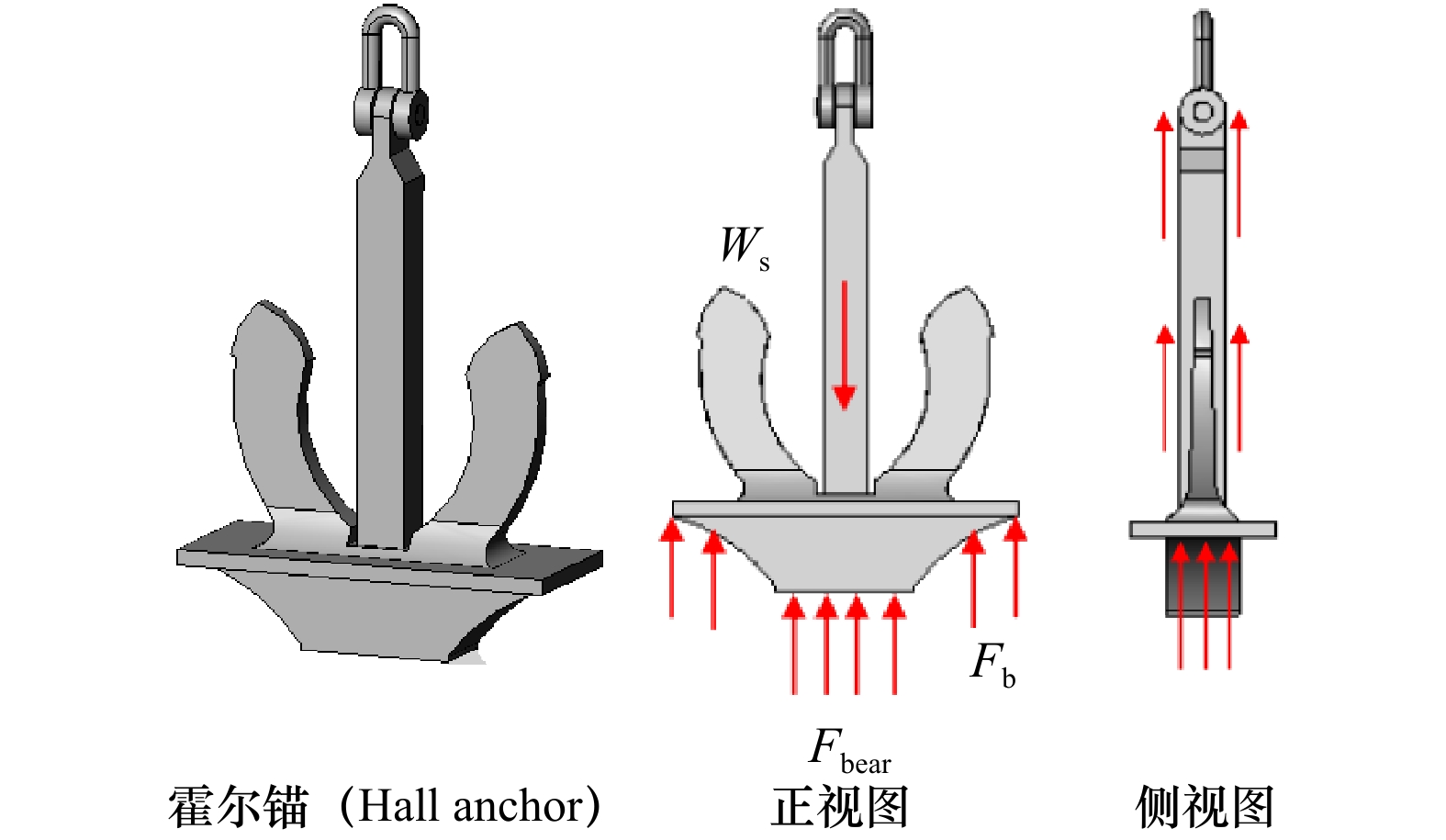
 下载:
下载:


